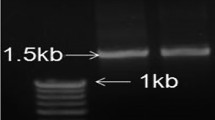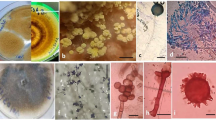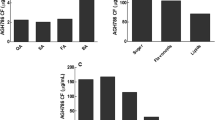Abstract
Phytophthora nicotianae is one of the most important soil-borne plant pathogens. Sporangia and zoospores of P. nicotianae are responsible for primary infection and disease dissemination. The disease caused by P. nicotianae was difficult to control by fungicide. Boron, an essential plant micronutrient, was found to have a direct effect on other pathogens. In this paper, the effects of B on the growth, antioxidant system and gene differential expression of P. nicotianae were tested. The results showed that 0.1 mM B could dramatically decrease the sporangiogenesis and zoosporogenesis of P. nicotianae. Mycelial growth of P. nicotianae was significantly inhibited when the concentration of B reached 8 mM. A high-quality differential expression sequence csn4 was obtained by gene differential expression analysis. Under the treated of B, csn4 expression was inhibited, activity of superoxide dismutase (SOD) and catalase (CAT) significantly decreased and the malondialdehyde (MDA) content notably increased compared to control. It is suggested that B could serve as a potential fungicide for the control of plant disease caused by P. nicotianae.




Similar content being viewed by others
References
Aebi, H. (1984). Catalase in vitro. Methods in Enymology, 105, 121–126.
Aguirre, J., Ríos-Momberg, M., Hewitt, D., & Hansberg, W. (2005). Reactive oxygen species and development in microbial eukaryotes. Trends in Microbiology, 13, 111–118.
Bittner, R. J., & Mila, A. L. (2016). Effects of oxathiapiprolin on Phytophthora nicotianae, the causal agent of black shank of tobacco. Crop Protection, 81, 57–64.
Blaya, J., Lloret, E., Santísima-Trinidad, A. B., Ros, M., & Pascual, J. A. (2015). Molecular methods (digital PCR and real-time PCR) for the quantification of low copy DNA of Phytophthora nicotianae in environmental samples. Pest Management Science, 72, 747–753.
Brown, P. H., & Hu, H. (1996). Phloem mobility of boron is species dependent: Evidence for phloem mobility in sorbitol-rich species. Annals of Botany, 77, 497–505.
Cervilla, L. M., Blasco, B., Rios, J. J., Romero, L., & Ruiz, J. M. (2007). Oxidative stress and antioxidants in tomato (Solanum lycopersicum) plants subjected to boron toxicity. Annals of Botany, 100, 747–756.
Dohmann, E. M., Kuhnle, C., & Schwechheimer, C. (2005). Loss of the CONSTITUTIVE PHOTOMORPHOGENIC9 signalosome subunit 5 is sufficient to cause the cop/det/fus mutant phenotype in Arabidopsis. The Plant Cell, 17, 1967–1978.
Dordas, C. (2008). Role of nutrients in controlling plant diseases in sustainable agriculture. A review. Agronomy for Sustainable Development, 28, 33–46.
Du, Z., & Bramlage, W. J. (1992). Modified thiobarbituric acid assay for measuring lipid oxidation in sugar-rich plant tissue extracts. Journal of Agricultural and Food Chemistry, 40, 1566–1570.
Falcón-Rodríguez, A. B., Costales, D., Cabrera, J. C., & Martínez-Téllez, M. A. (2011). Chitosan physico-chemical properties modulate defense responses and resistance in tobacco plants against the oomycete Phytophthora nicotianae. Pesticide Biochemistry and Physiology, 100, 221–228.
Frenkel, O., Yermiyahu, U., Forbes, G. A., Fry, W. E., & Shtienberg, D. (2010). Restriction of potato and tomato late blight development by sub-phytotoxic concentrations of boron. Plant Pathology, 59, 626–633.
Giannopolitis, C. N., & Ries, S. K. (1977). Superoxide dismutases: I. Occurrence in higher plants. Plant Physiology, 59, 309–314.
Hwang, C. Y., Ryu, Y. S., Chung, M. S., Kim, K. D., Park, S. S., et al. (2004). Thioredoxin modulates activator protein 1 (AP-1) activity and p27Kip1 degradation through direct interaction with Jab1. Oncogene, 23, 8868–8875.
Kong, P., Hong, C., Jeffers, S. N., & Richardson, P. A. (2003). A species-specific polymerase chain reaction assay for rapid detection of Phytophthora nicotianae in irrigation water. Phytopathology, 93, 822–831.
Licursi, V., Salvi, C., De Cesare, V., Rinaldi, T., Mattei, B., et al. (2014). The COP9 signalosome is involved in the regulation of lipid metabolism and of transition metals uptake in Saccharomyces cerevisiae. FEBS Journal, 281, 175–190.
Liu, D., Jiang, W., Zhang, L., & Lufang, L. I. (2000). Effects of boron ions on root growth and cell division of broadbean (vicia faba l.) Israel Journal of Plant Sciences, 48, 47–51.
Masago, H., Yoshikawa, M., & Nakanishi, N. (1977). Selective inhibition of Pythium spp. on a medium for direct isolation of Phytophthora spp. from soils and plants. Phytopatology, 67, 425–428.
Mondol, M. A. M., Surovy, M. Z., Islam, M. T., Schüffler, A., & Laatsch, H. (2015). Macrocyclic trichothecenes from Myrothecium roridum strain M10 with motility inhibitory and zoosporicidal activities against Phytophthora nicotianae. Journal of Agricultural and Food Chemistry, 63, 8777–8878.
Qin, G., Tian, S., Chan, Z., & Li, B. (2007). Crucial role of antioxidant proteins and hydrolytic enzymes in pathogenicity of Penicillium expansum. Molecular & Cellular Proteomics, 6, 425–438.
Qin, G., Zong, Y., Chen, Q., Hua, D., & Tian, S. (2010). Inhibitory effect of boron against Botrytis cinerea on table grapes and its possible mechanisms of action. International Journal of Food Microbiology, 138, 145–150.
Rao, K. M., & Sresty, T. V. S. (2000). Antioxidative parameters in the seedlings of pigeonpea (Cajanus cajan (L.) Millspaugh) in response to Zn and Ni stresses. Plat Science, 157, 113–128.
Rolshausen, P. E., & Gubler, W. D. (2005). Use of boron for the control of Eutypa dieback of grapevines. Plant Disease, 89, 734–738.
Ryden, P., Sugimoto-Shirasu, K., Smith, A. C., Findlay, K., Reiter, W. D., & McCann, M. C. (2003). Tensile properties of Arabidopsis cell walls depend on both a xyloglucan cross-linked microfibrillar network and rhamnogalacturonan II-borate complexes. Plant Physiology, 132, 1033–1040.
Saitoh, K., Togashi, K., Arie, T., & Teraoka, T. (2006). A simple method for a mini-preparation of fungal DNA. Journal of General Plant Pahology, 72, 348–350.
Thomidis, T., & Exadaktylou, E. (2010). Effect of boron on the development of brown rot (Monilinia laxa) on peaches. Crop Protection, 29, 52–576.
Tooley, P. W., Browning, M., & Leighty, R. M. (2013). Inoculum density relationships for infection of some eastern us forest species by phytophthora ramorum. Journal of Phytopathology, 161, 595–603.
Voxeur, A., & Fry, S. C. (2014). Glycosylinositol phosphorylceramides from Rosa cell cultures are boron-bridged in the plasma membrane and form complexes with rhamnogalacturonan II. Plant Journal, 79, 139–149.
Wang, J., Hu, Q., Chen, H., Zhou, Z., Li, W., Wang, Y., et al. (2010). Role of individual subunits of the Neurospora crassa CSN complex in regulation of deneddylation and stability of cullin proteins. PLoS Genetics, 6, 267–276.
Warington, K. (1923). The effect of boric acid and borax on the broad bean and certain other plants. Annals of Botany, 37, 629–672.
Yulia, K., Carmela, P. M., Rocco, R., et al. (2016). Effect of boron and zinc application on HXK1 and MAKR6 gene expression in strawberry. Emirates Journal of Food and Agriculture, 28, 317–325.
Zhao, W. J., Han, J. R., & Long, D. D. (2015). Effect of copper-induced oxidative stress on sclerotial differentiation, endogenous antioxidant contents, and antioxidative enzyme activities of Penicillium thomii PT95. Annals of Microbiology, 65, 1505–1514.
Acknowledgements
This work was supported by the National Key Research and Developmental Program of China (2016YFC0502303).
Author information
Authors and Affiliations
Corresponding author
Rights and permissions
About this article
Cite this article
Qiao, Y., Yang, S., Wang, H. et al. Effect of boron on mycelial growth, sporangiogenesis and zoosporogenesis of Phytophthora nicotianae and the possible inhibitory mechanisms. Eur J Plant Pathol 149, 945–952 (2017). https://doi.org/10.1007/s10658-017-1244-3
Accepted:
Published:
Issue Date:
DOI: https://doi.org/10.1007/s10658-017-1244-3




